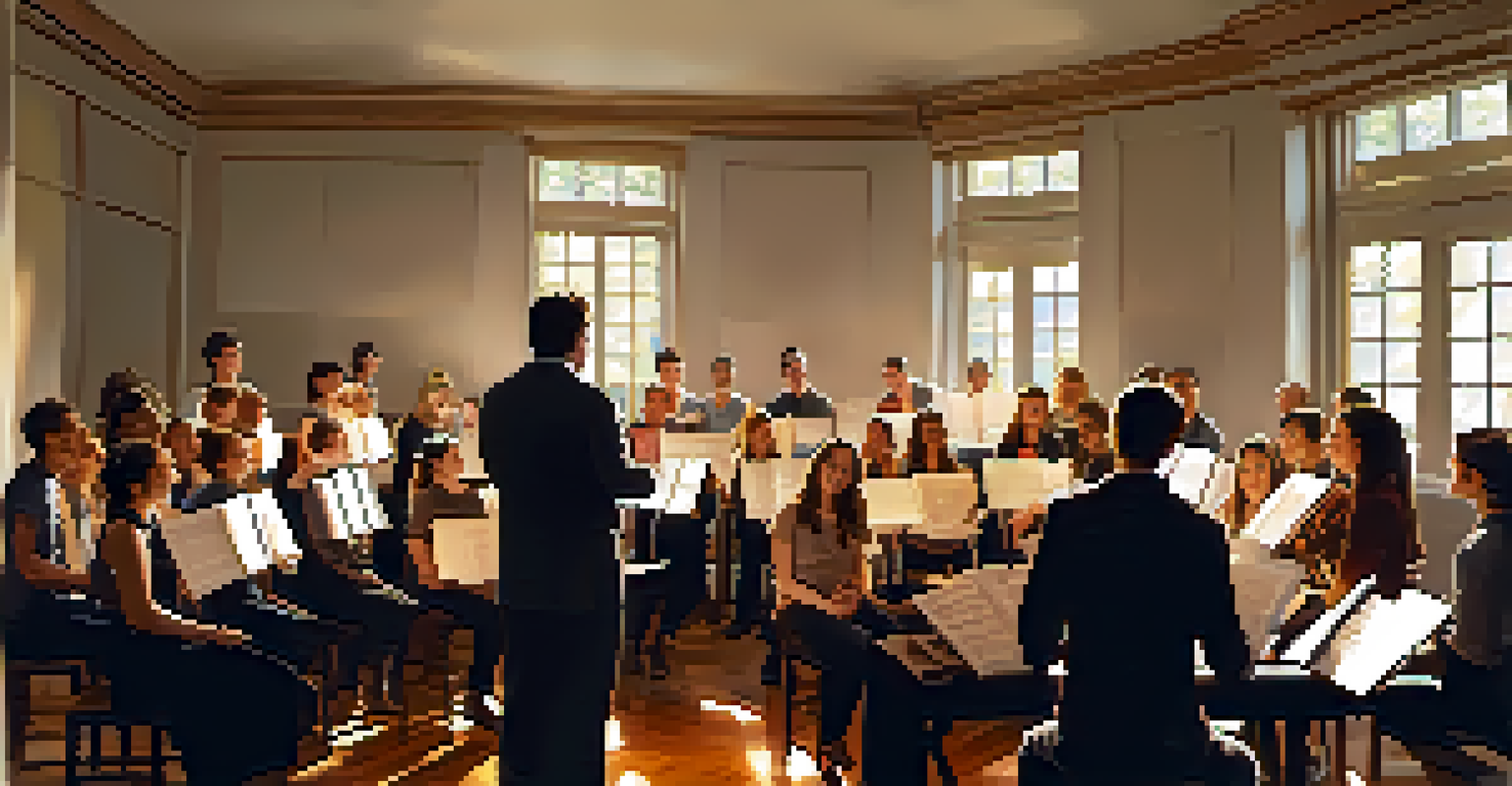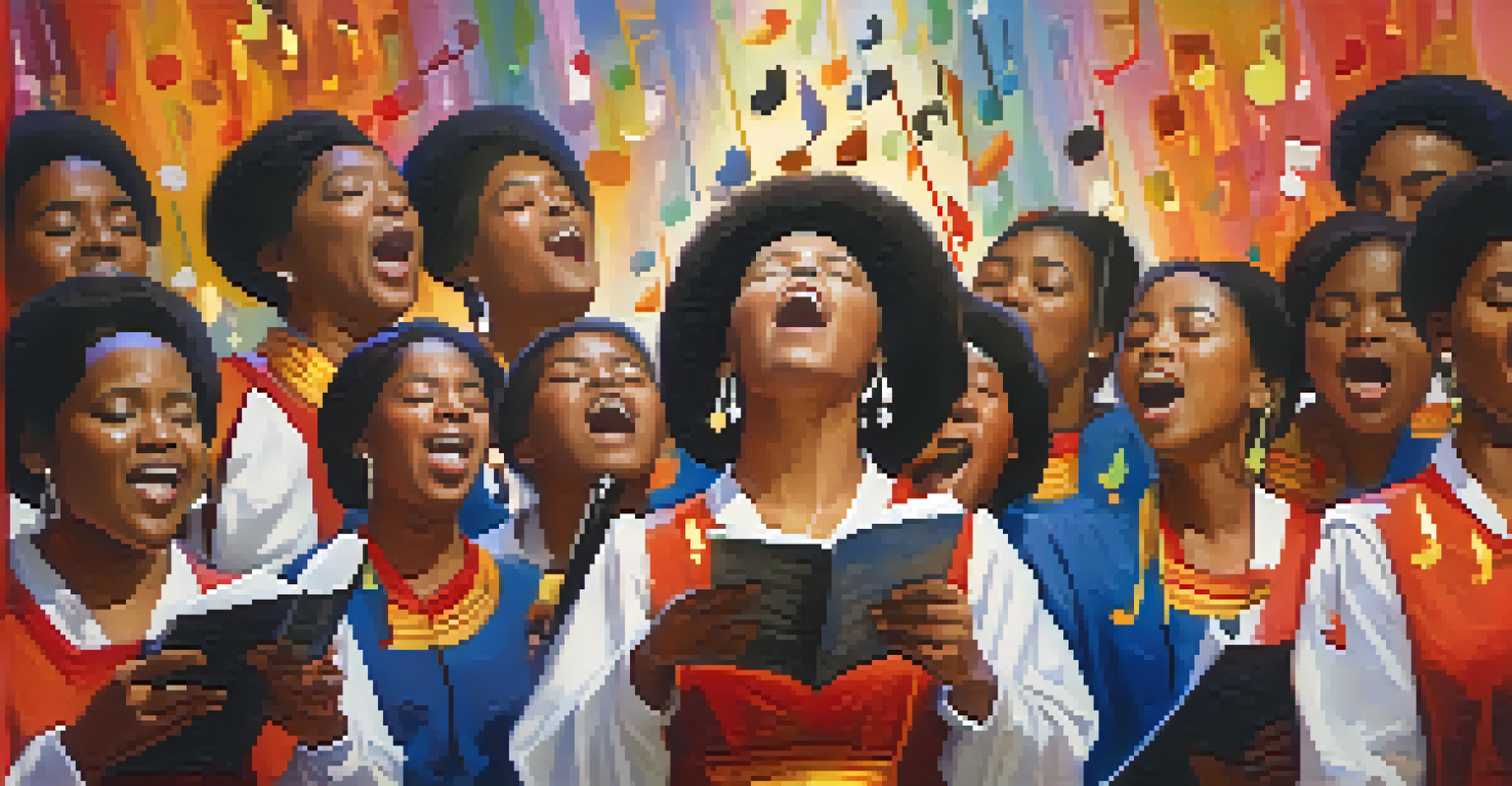Exploring World Music in Choral Repertoire

The Importance of World Music in Choral Education
World music plays a crucial role in choral education by exposing singers to various cultural expressions. This enriches their understanding of music as a universal language, fostering appreciation for diversity. By incorporating pieces from different regions, choirs can create a more inclusive environment that celebrates global traditions.
Music is the universal language of mankind.
When choirs perform songs from around the world, they not only learn new musical techniques but also gain insight into the stories and histories behind the pieces. This encourages empathy and connection among singers, making rehearsals and performances more meaningful. As singers share these experiences, they develop a deeper bond with one another and the music.
Additionally, exploring world music can enhance vocal skills, as different cultures often employ unique singing techniques. For example, African call-and-response traditions or the intricate harmonies found in Eastern European folk songs challenge singers to expand their vocal repertoire. This diversity ultimately contributes to a well-rounded choral experience.
Diverse Genres and Their Unique Characteristics
World music encompasses a vast array of genres, each with its own distinct characteristics that can enhance choral repertoire. For instance, the rhythmic complexities of Afro-Brazilian music invite choirs to explore syncopation and polyrhythms, while traditional Indian classical music introduces intricate melodic structures and improvisation. By engaging with these genres, choirs can broaden their musical horizons.

Incorporating folk music from various cultures allows for a rich exploration of storytelling through song. Songs like 'Siyahamba' from South Africa or 'Kalinka' from Russia not only showcase unique melodies but also reflect the cultural narratives behind them. When choirs perform these pieces, they are not just singing; they are sharing a piece of a community's history and identity.
World Music Enriches Choral Education
Incorporating world music in choral programs enhances cultural understanding and fosters appreciation for diversity among singers.
Furthermore, blending genres can lead to innovative arrangements that capture the essence of multiple traditions. For example, a piece that combines elements of gospel and traditional African music can create a vibrant and uplifting experience. This fusion not only excites singers but also resonates with audiences, making performances memorable.
The Role of Cultural Context in Performance
Understanding the cultural context of a piece is essential for an authentic performance. When choirs delve into the origins of a song, they can better convey its emotional depth and significance. For instance, singing a traditional hymn from a specific culture without grasping its background can lead to a lack of connection with the music and its message.
The beauty of music is that it transcends all boundaries and brings us together.
Incorporating cultural elements such as choreography, instruments, and costumes can further enhance the performance. For example, a choir performing a Mexican folk song might include traditional dance or use maracas to enrich the auditory experience. This not only keeps audiences engaged but also provides singers with a multi-sensory understanding of the piece.
Additionally, inviting guest musicians or cultural experts to participate in rehearsals can deepen the choir's appreciation for the music. These collaborations allow singers to learn directly from those who embody the traditions, ensuring that performances are both respectful and authentic. This commitment to cultural understanding elevates the overall quality of the choir's work.
Innovative Arrangements of World Music for Choirs
Innovative arrangements of world music can breathe new life into choral repertoire, making traditional pieces accessible to modern audiences. Composers and arrangers often blend various musical styles, creating unique interpretations that still honor the original work. This not only showcases the versatility of the choir but also highlights the richness of global music traditions.
For example, a contemporary arrangement of a traditional song might incorporate harmonies from Western classical music while retaining the original melody. This fusion can attract a wider audience, engaging both those familiar with the culture and those experiencing it for the first time. Such arrangements encourage choirs to think creatively and explore new ways of presenting familiar pieces.
Cultural Context Enhances Performance
Understanding the cultural background of songs allows choirs to deliver more authentic and emotionally resonant performances.
Moreover, utilizing technology in arrangements can enhance performances. Incorporating digital elements, such as recorded instrumentals or multimedia presentations, can create a captivating experience for both singers and audiences. This innovative approach invites choirs to experiment with sound and visuals, making performances more dynamic and memorable.
Fostering Global Connections Through Choral Music
Choral music has a unique ability to foster global connections among singers and audiences alike. By performing world music, choirs create a platform for cultural exchange, allowing individuals to share their stories and experiences through song. This shared experience can break down barriers and build bridges between different communities.
Participating in international choral festivals or collaborations with choirs from other countries further strengthens these connections. Such events provide opportunities for singers to learn from one another, share techniques, and even perform together. These interactions can lead to lifelong friendships and a greater appreciation for global diversity.
Additionally, choirs can use their platform to advocate for social issues relevant to the cultures they represent. By highlighting songs that address themes like peace, justice, or environmental awareness, choirs can inspire audiences to engage with these important topics. This commitment to global citizenship enriches the choir's mission and impact.
The Challenges of Incorporating World Music
While the incorporation of world music into choral repertoire is rewarding, it also presents challenges. One major hurdle is ensuring cultural sensitivity and authenticity in performance. Choir directors must be mindful of how they portray a culture's music and avoid appropriation, which can lead to misrepresentation and misunderstanding.
Additionally, finding appropriate arrangements that stay true to the original piece can be a challenge. Not all traditional songs have readily available choral arrangements, which may require directors to create their own or adapt existing ones. This process can be time-consuming, but it also offers a valuable opportunity for creativity and collaboration among choir members.
Global Connections Through Singing
Performing world music provides choirs with opportunities for cultural exchange, fostering global connections and community understanding.
Lastly, language barriers can pose difficulties when performing songs in unfamiliar languages. Singers might struggle with pronunciation or the subtle nuances of the language, which can affect the overall performance. Providing resources and support, such as language workshops, can help singers feel more confident and prepared.
The Future of World Music in Choral Repertoire
As the world becomes increasingly interconnected, the future of world music in choral repertoire looks bright. Choirs around the globe are recognizing the importance of diversity and cultural representation in their programs. This shift not only enriches the musical landscape but also reflects the values of inclusivity and respect for all cultures.
Innovative technology and online resources are making it easier for choirs to access and learn about world music. With platforms that provide sheet music, recordings, and educational materials, choir directors can explore a wider range of repertoire with their singers. This accessibility encourages choirs to experiment and push the boundaries of their musical exploration.

Ultimately, the continued integration of world music into choral repertoire will foster a greater sense of community and understanding among diverse populations. As choirs share these rich traditions and stories, they will contribute to a more harmonious world, united through the power of music.